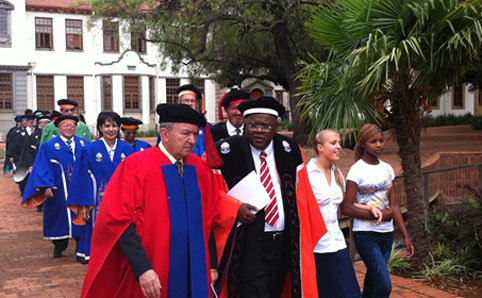 |
|
Justice Richard Goldstone received an honorary doctorate from the university on 3 February 2012.
Photo: Duard Grobbelaar
|
Dumela article (pdf document)
Justice Richard Goldstone's - acceptance speech (pdf document)
Mail & Guardian article (pdf document)
The University of the Free State (UFS) is determined to make a success of its academic and human projects, and is not prepared to compromise on standards in the process.
This was the message of Prof. Jonathan Jansen, Vice-Chancellor and Rector, at our universities official opening on Friday 3 February 2012. These projects, said Prof. Jansen, are the foundation of the institution.
The official opening coincided with an honorary doctorate in Law conferred on Justice Richard Goldstone.
The UFS has enrolled the “smartest and most diverse class since 1904,” Prof. Jansen said.
Top learners with six A’s, and more learners from top schools inside and outside South Africa, have made the UFS their university of choice. “We are determined that the best students must study at Kovsies.”
Prof. Jansen also referred to learners in the school system who sit and wait while teachers fight amongst themselves at the education departments. “What are we going to do with those students?” The UFS provides an opportunity for these students to enter higher education with its University Preparation Programme on its South Campus in Bloemfontein. “The fastest growth at our university is on this campus. It is set aside for children who cannot be taken up in the mainstream.”
Some of the students who were part of this programme are doctors, lawyers and teachers today.
“We set a high standard in our academic project to make sure our students are the best available.”
In its Schools Project, the UFS has 23 schools under its wing and the net is broadening. Pass rates in these schools improved dramatically; in some from 13% to 100% in one year.
The human project sets standards for good behaviour. “I was astounded to see how young people get together to find other people as human beings,” Jansen said. “I have enormous hope for this country.
Some of the other projects he mentioned were the provision of more space for students to study, a refocus on the Qwaqwa Campus in the Eastern Free State, the placement of new academics, and agreements with universities abroad on the placement of young scholars.
After receiving his honorary doctorate, Justice Goldstone congratulated the university on the fact that transformation did not lead to standards being compromised.
“The university now takes its place as a leading university on our continent. The leaders of the university can hold their heads up high about their achievements.”
Judge Goldstone, the bearer of 26 honorary doctorates from various countries around the world, said: “It is always good to be honored at home”.
The official opening was attended by staff, students, guests and community leaders.
Media Release
3 February 2012
Issued by: Lacea Loader
Director: Strategic Communication
Tel: 051 401 2584
Cell: 083 645 2454
E-mail: news@ufs.ac.za